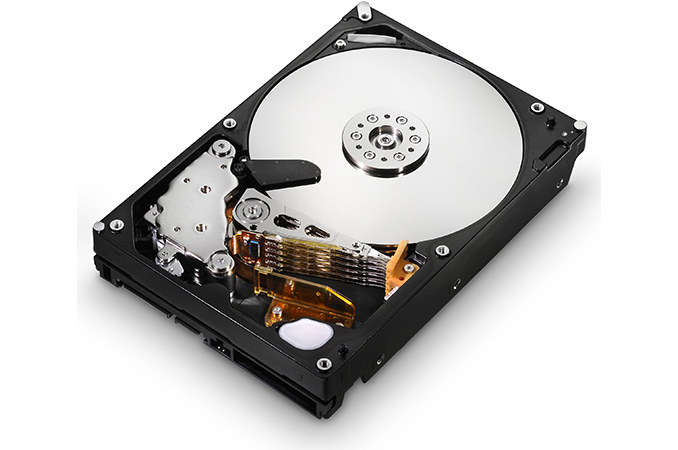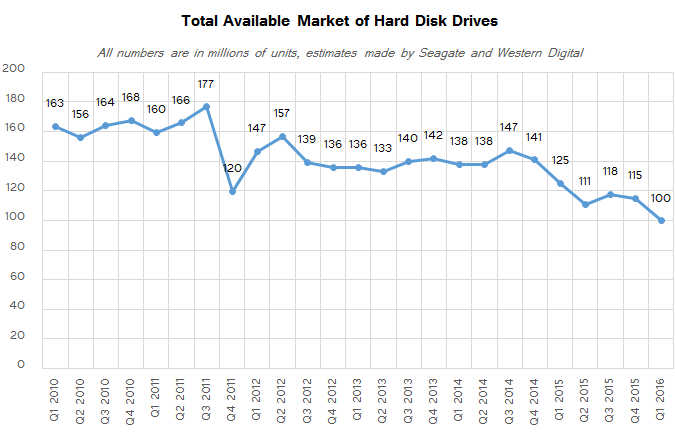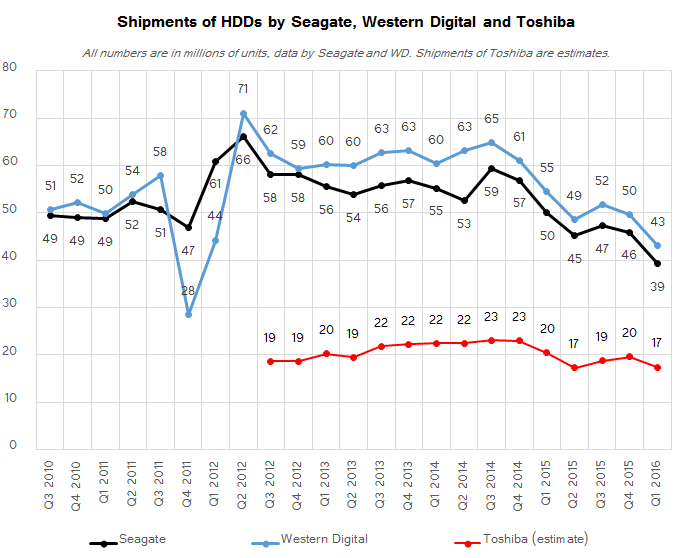Market Views: HDD Shipments Down 20% in Q1 2016, Hit Multi-Year Low
by Anton Shilov on May 12, 2016 8:00 AM EST
Leading industry watchers like IDC and Gartner early this year predicted that the first quarter of 2016 would not be good for the PC industry and various companies agreed with that. The reasons for the declines are well known: global economic issues, the slowdown in China, the strong U.S. dollar as well as competition from smartphones and other devices. As sales of PCs were not strong as predicted, this negatively affected the hard drive market.
According to Gartner, PC shipments worldwide totaled 64.8 million units in the first quarter of 2016, a decrease of 9.6% from Q1 2015. The company notes that this was the first time since 2007 that shipment volume fell below 65 million units. Analysts from IDC are even more pessimistic because based on their findings, shipments of PCs in the first quarter totaled 60.6 million units, a year-over-year (YoY) drop of 11.5%. As we noted in our previous coverage of the HDD market earlier this year, the decline of HDD shipments in 2015 significantly outpaced the regress of the PC market. As it appears, the same happened in the first quarter of 2016 as the total available market of hard drives dropped to a new multi-year low.
Shipments of HDDs Total 99.8 Million Units in Q1 2016
Seagate, Toshiba and Western Digital, the three remaining producers of HDDs, shipped a total of 99.8 million hard drives in Q1 2016, or 20% less than in the same period a year ago according to their estimates (see counting methodology below). According to estimates from Nidec, the company that sells the majority of small precision motors for HDDs (over 80% of them, based on its own estimates), the industry sold 98 million hard drives in Q1, but it is worth noting that Nidec is typically very conservative. In the same quarter of last year, Seagate, Toshiba and Western Digital sold 125 million HDDs, whereas just six years ago the industry shipped 163 million units. In fact, even in Q1 2006, sales of HDDs totaled 101.7 million units, according to iSuppli (via EDN), which means that we might be talking about a 10-year low in hard drives shipments.
Sales of PCs in general (and hard drives in particular) are seasonally not strong in the first quarter of the year, which is why it is not surprising that they declined to around 100 million units from 115 million units in Q4 2015. What is alarming is that despite this seasonal change, Q1 2015 shipments of HDDs were higher than sales of hard drives in each of the remaining quarters last year. If this year follows the same negative pattern, then HDD shipments will be below 100 million units in the second quarter and will remain below that level in the second half of the year. Western Digital estimates that total available market (TAM) of HDDs will decline to 95 million units in the second quarter, which means a decline of around 15% from the same period last year. A moderately good news is that Western Digital seems to be optimistic about the second half and believes that HDD TAM will remain above 400 million units mark in 2016 (compared to 456 million units in 2015), which means that shipments of hard drives will grow in calendar Q3 and calendar Q4. IDC has asserted that inventory reductions, cautious buying and other additional elements of the equation that directly affected makers of components in the recent quarters are wrapping up, Western Digital’s optimism could well be justified.












116 Comments
View All Comments
nils_ - Monday, May 30, 2016 - link
Is anyone still buying those 15k or even 10k drives?glad2meetu - Friday, May 13, 2016 - link
I think people are waiting to see what comes out of the merger between WD and Sandisk. I am surprised that Seagate did not make a bid late last year for Micron.I think much of the blame for the decline in the PC market in general is due to Intel failing to innovate. The drop in HDD shipments effectively just mirrors the lower number of new computers being shipped. But that may be a bit harsh on Intel and the rest of the PC industry. It has become much more difficult to make a game changing product given the level of excellence found in existing technology. The same can be said for smartphones.
Hard drives may turn around in another couple of years if designers can get hybrid drives to work as intended. Or perhaps 3D XPoint lives up to the hype and changes the market in another few years.
There also is a risk that the cost reduction on SSDs comes back to haunt them. General consumers will just lump all SSDs together or may view them based on brand names. So SSD makers could get hurt if the cheapest SSDs run into more issues for consumers.
avbohemen - Friday, May 13, 2016 - link
With these numbers, I am wondering: does this include disks delivered to the cloud providers (AWS, Azure, Google), Facebook and other big consumers? They are always expanding their datacenters and use a lot of storage, while no one seems to really know how big their "market share" is. Can anyone share some insight in this?Pix2Go - Friday, May 13, 2016 - link
The numbers in the article do include those customers. They typically are the ones using "Enterprise" drives, with some exceptions.As an idea of how many drives they need, consider this random nugget from "the internet":
"The volumes of storage Google needs are insane: as the post notes, YouTube alone requires a petabyte of new storage every single day."
Yep, at least 1000TB a day in new storage requirements. And I'd bet that's a low estimate.
This link doesn't give a solid answer, but gives some ideas about how much data is really out there. https://www.backblaze.com/blog/200-petabytes-of-cu...
revanchrist - Friday, May 13, 2016 - link
Couldn't agreed more with what some already said. The per GB price of HDD will not go further down, it will just stay stagnant. Right now the lowest per GB price is on 3TB and 4TB drives, once you go further up eyeing for 5TB and more, the prices simply rocket sky high. I think in the future, all those 1TB and 2TB drives will go extinct while 5TB and higher prices will drop down to the level of 3TB and 4TB. 1TB and lower storage space belongs to the SSD, and it will happen very soon.StrangerGuy - Friday, May 13, 2016 - link
My educated guess is that costs of HDDs doesn't scale well at the low end since HDD manufacturers still have to build the entire drive assembly minus platters for a 1TB or less HDD while NAND is far more flexible in physical packaging.zodiacfml - Friday, May 13, 2016 - link
LOL. I feel bad for these ageing kings of storage.They have to throw out their cash and apply for some loans to be build a NAND fab. It is the only way to stay relevant for the next 10 to 20 years. SSDs are already eating from the top and bottom of the food chain. The last remaining stronghold of HDDs is cost per GB; but SSDs doesn't have to go there as HDDs didn't replaced Tape drives for cost per GB.
zodiacfml - Friday, May 13, 2016 - link
Edit: Got carried away and forgot WDs acquisition of Sandisk which puts them on track. Seagate, just do it.vivekvs1992 - Saturday, May 14, 2016 - link
Most of the reasons for declining sales are because of steafy decline in the pricing of small to medium capacity ssd, hdd are used for long term storage nowadays and those drives are never below 1tb, personally i have 2 2tb usb hdd, 1 1tb usb hdd and a 2 tb in my build, and 2 more 2 tb beauties are on their way... The thing is many of my friends don't consider that they can add another hard disk without removing the old one in a desktop, another lot of them don't need so m7ch storage and the last lot are unaware of this data expansion methodFriendlyUser - Saturday, May 14, 2016 - link
For a lot of stuff we have gone from "owning" digital libraries to "subscribing". If people had to locally store their netflix content or their Amazon books and their MP3s, the need for space would have grown considerably. With a fast network you can always rely on re-downloading content you want, instead of storing.Also, in my opinion, the industry has stagnated. Price per GB is today similar to what I paid the last time I upgraded my HDs, in 2009. This is unacceptable. I know I would have bought a ton of 2.5" 2TB HDs for backups and the like, but they are still priced at ~$100. Too expensive... Plus, there has been little progress with hybrid HD/SSDs, which would be a great solution for people who don't want to mess with multiple drives. In fact, all I see is rebranding the same drive with slightly modified firmware and selling it as "NAS" or "workstation" or "IP camera" or "NAS pro" or "Storage" etc.
They have been milking us for too long. Time to start innovating.